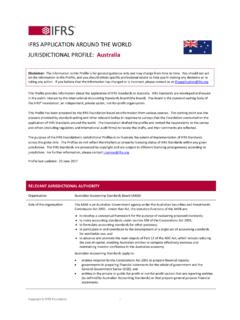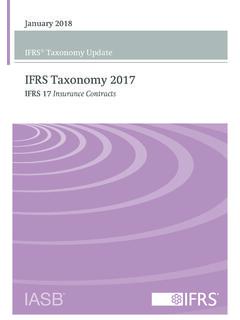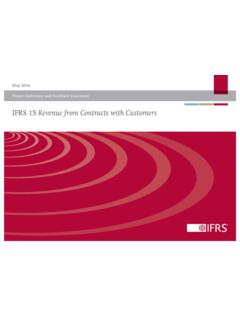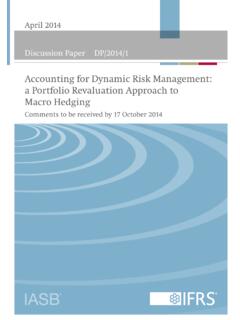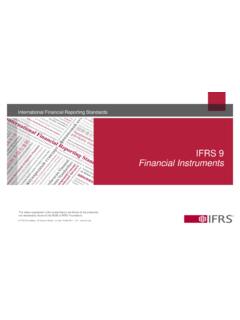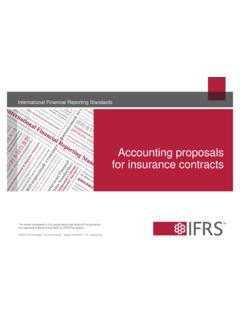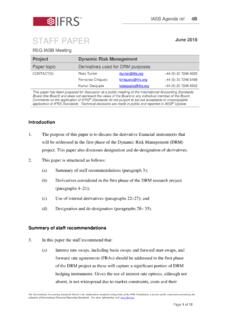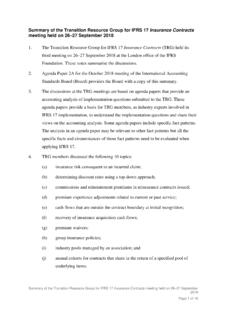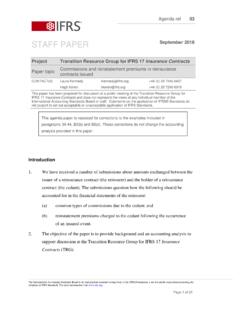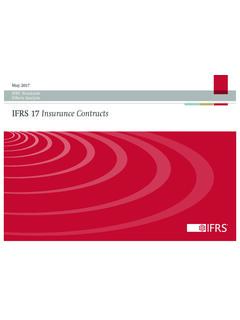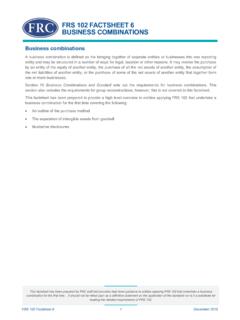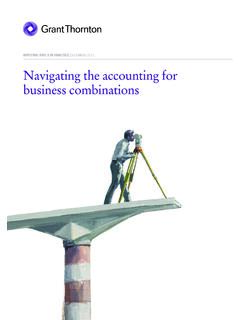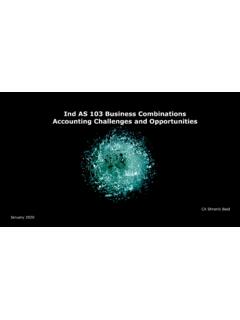Transcription of IFRS 3 – 2021 Issued IFRS Standards (Part A)
1 IFRS 3 business CombinationsIn April 2001 the International Accounting Standards Board (Board) adoptedIAS 22 business Combinations, which had originally been Issued by the InternationalAccounting Standards Committee in October 1998. IAS 22 was itself a revised version ofIAS 22 business Combinations that was Issued in November March 2004 the Board replaced IAS 22 and three related Interpretations (SIC-9 BusinessCombinations Classification either as Acquisitions or Unitings of Interests, SIC-22 BusinessCombinations Subsequent Adjustment of Fair Values and Goodwill InitiallyReported and SIC-28 business Combinations Date of Exchange and Fair Value of EquityInstruments) when it Issued IFRS 3 business amendments were made to IFRS 3 in March 2004 by IFRS 5 Non-current Assets Heldfor Sale and Discontinued Operations and IAS 1 Presentation of Financial Statements (as revised inSeptember 2007)
2 , which amended the terminology used throughout the Standards ,including IFRS January 2008 the Board Issued a revised IFRS 3. Please refer to Background Information inthe Basis for Conclusions on IFRS 3 for a fuller description of those October 2018, the Board amended IFRS 3 by issuing Definition of a business (Amendmentsto IFRS 3). This amended IFRS 3 to narrow and clarify the definition of a business , and topermit a simplified assessment of whether an acquired set of activities and assets is agroup of assets rather than a May 2020, the Board amended IFRS 3 by issuing Reference to the Conceptual updated a reference in IFRS 3 and made further amendments to avoid unintendedconsequences of updating the Standards have made minor consequential amendments to IFRS 3. Theyinclude Improvements to IFRSs ( Issued in May 2010), IFRS 10 Consolidated FinancialStatements ( Issued May 2011), IFRS 13 Fair Value Measurement ( Issued May 2011), InvestmentEntities (Amendments to IFRS 10, IFRS 12 and IAS 27) ( Issued October 2012),IFRS 9 Financial Instruments (Hedge Accounting and amendments to IFRS 9, IFRS 7 andIAS 39) ( Issued November 2013), Annual Improvements to IFRSs 2010 2012 Cycle (issuedDecember 2013), Annual Improvements to IFRSs 2011 2013 Cycle ( Issued December 2013),IFRS 15 Revenue from Contracts with Customers ( Issued May 2014), IFRS 9 FinancialInstruments ( Issued July 2014), IFRS 16 Leases ( Issued January 2016), IFRS 17 InsuranceContracts ( Issued May 2017)
3 , Annual Improvements to IFRS Standards 2015 2017 Cycle (issuedDecember 2017), Amendments to References to the Conceptual Framework in IFRSS tandards ( Issued March 2018) and Amendments to IFRS 17 ( Issued June 2020).IFRS 3 IFRS FoundationA191 CONTENTS from paragraphINTERNATIONAL FINANCIAL REPORTING STANDARD 3 business COMBINATIONSOBJECTIVE1 SCOPE2 IDENTIFYING A business COMBINATION3 THE ACQUISITION METHOD4 Identifying the acquirer6 Determining the acquisition date8 Recognising and measuring the identifiable assets acquired, the liabilitiesassumed and any non-controlling interest in the acquiree10 Recognising and measuring goodwill or a gain from a bargain purchase32 Additional guidance for applying the acquisition method to particular typesof business combinations41 Measurement period45 Determining what is part of the business combination transaction51 SUBSEQUENT MEASUREMENT AND ACCOUNTING54 Reacquired rights55 Contingent liabilities56 Indemnification assets57 Contingent consideration58 DISCLOSURES59 EFFECTIVE DATE AND TRANSITION64 Effective date64 Transition65 REFERENCE TO IFRS 967 AWITHDRAWAL OF IFRS 3 (2004)
4 68 APPENDICESA Defined termsB Application guidanceC Amendments to other IFRSsAPPROVAL BY THE BOARD OF IFRS 3 Issued IN JANUARY 2008 APPROVAL BY THE BOARD OF DEFINITION OF A business Issued INOCTOBER 2018 APPROVAL BY THE BOARD OF REFERENCE TO THE CONCEPTUALFRAMEWORK Issued IN MAY 2020 FOR THE ACCOMPANYING GUIDANCE LISTED BELOW, SEE PART B OF THIS EDITIONILLUSTRATIVE 3A192 IFRS to guidance on other IFRSsFOR THE BASIS FOR CONCLUSIONS, SEE PART C OF THIS EDITIONBASIS FOR CONCLUSIONSAPPENDIX TO THE BASIS FOR CONCLUSIONSA mendments to the Basis for Conclusions on other IFRSsDISSENTING OPINIONSIFRS 3 IFRS FoundationA193 International Financial Reporting Standard 3 business Combinations (IFRS 3) is set outin paragraphs 1 68 and Appendices A C. All the paragraphs have equal in bold type state the main principles. Terms defined in Appendix A arein italics the first time they appear in the IFRS.
5 Definitions of other terms are given inthe Glossary for International Financial Reporting Standards . IFRS 3 should be read inthe context of its objective and the Basis for Conclusions, the Preface to IFRSS tandards and the Conceptual Framework for Financial Reporting. IAS 8 Accounting Policies,Changes in Accounting Estimates and Errors provides a basis for selecting and applyingaccounting policies in the absence of explicit 3A194 IFRS FoundationInternational Financial Reporting Standard 3 business CombinationsObjectiveThe objective of this IFRS is to improve the relevance, reliability andcomparability of the information that a reporting entity provides in itsfinancial statements about a business combination and its effects. To accomplishthat, this IFRS establishes principles and requirements for how the acquirer:(a)recognises and measures in its financial statements the identifiableassets acquired, the liabilities assumed and any non-controlling interest inthe acquiree;(b)recognises and measures the goodwill acquired in the businesscombination or a gain from a bargain purchase; and(c)determines what information to disclose to enable users of thefinancial statements to evaluate the nature and financial effects of thebusiness IFRS applies to a transaction or other event that meets the definition of abusiness combination .
6 This IFRS does not apply to:(a)the accounting for the formation of a joint arrangement in thefinancial statements of the joint arrangement itself.(b)the acquisition of an asset or a group of assets that does not constitutea business . In such cases the acquirer shall identify and recognise theindividual identifiable assets acquired (including those assets that meetthe definition of, and recognition criteria for, intangible assets in IAS 38 Intangible Assets) and liabilities assumed. The cost of the group shall beallocated to the individual identifiable assets and liabilities on the basisof their relative fair values at the date of purchase. Such a transaction orevent does not give rise to goodwill.(c)a combination of entities or businesses under common control(paragraphs B1 B4 provide related application guidance).
7 The requirements of this Standard do not apply to the acquisition by aninvestment entity, as defined in IFRS 10 Consolidated Financial Statements, of aninvestment in a subsidiary that is required to be measured at fair valuethrough profit or a business combinationAn entity shall determine whether a transaction or other event isa business combination by applying the definition in this IFRS, whichrequires that the assets acquired and liabilities assumed constitutea business . If the assets acquired are not a business , the reporting entity122A3 IFRS 3 IFRS FoundationA195shall account for the transaction or other event as an assetacquisition. Paragraphs B5 B12D provide guidance on identifying abusiness combination and the definition of a acquisition methodAn entity shall account for each business combination by applying theacquisition the acquisition method requires:(a)identifying the acquirer;(b)determining the acquisition date;(c)recognising and measuring the identifiable assets acquired, theliabilities assumed and any non-controlling interest in the acquiree;and(d)recognising and measuring goodwill or a gain from a bargain the acquirerFor each business combination , one of the combining entities shall beidentified as the guidance in IFRS 10 shall be used to identify the acquirer the entity thatobtains control of another entity, ie the acquiree.
8 If a business combination hasoccurred but applying the guidance in IFRS 10 does not clearly indicate whichof the combining entities is the acquirer, the factors in paragraphsB14 B18 shall be considered in making that the acquisition dateThe acquirer shall identify the acquisition date, which is the date on whichit obtains control of the date on which the acquirer obtains control of the acquiree is generally thedate on which the acquirer legally transfers the consideration, acquires theassets and assumes the liabilities of the acquiree the closing date. However,the acquirer might obtain control on a date that is either earlier or later thanthe closing date. For example, the acquisition date precedes the closing date ifa written agreement provides that the acquirer obtains control of the acquireeon a date before the closing date.
9 An acquirer shall consider all pertinent factsand circumstances in identifying the acquisition 3A196 IFRS FoundationRecognising and measuring the identifiable assetsacquired, the liabilities assumed and any non-controllinginterest in the acquireeRecognition principleAs of the acquisition date, the acquirer shall recognise, separately fromgoodwill, the identifiable assets acquired, the liabilities assumed and anynon-controlling interest in the acquiree. Recognition of identifiable assetsacquired and liabilities assumed is subject to the conditions specified inparagraphs 11 and conditionsTo qualify for recognition as part of applying the acquisition method,the identifiable assets acquired and liabilities assumed must meet thedefinitions of assets and liabilities in the Conceptual Framework for FinancialReporting at the acquisition date.
10 For example, costs the acquirer expects but isnot obliged to incur in the future to effect its plan to exit an activity ofan acquiree or to terminate the employment of or relocate an acquiree semployees are not liabilities at the acquisition date. Therefore, the acquirerdoes not recognise those costs as part of applying the acquisition , the acquirer recognises those costs in its post- combination financialstatements in accordance with other addition, to qualify for recognition as part of applying the acquisitionmethod, the identifiable assets acquired and liabilities assumed must be partof what the acquirer and the acquiree (or its former owners) exchanged inthe business combination transaction rather than the result of separatetransactions. The acquirer shall apply the guidance in paragraphs 51 53 todetermine which assets acquired or liabilities assumed are part of theexchange for the acquiree and which, if any, are the result of separatetransactions to be accounted for in accordance with their nature and theapplicable acquirer s application of the recognition principle and conditions mayresult in recognising some assets and liabilities that the acquiree had notpreviously recognised as assets and liabilities in its financial statements.
